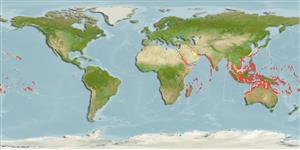Environment: milieu / climate zone / depth range / distribution range
Ecologia
marinhas associadas(os) a recifes; intervalo de profundidade 0 - 60 m (Ref. 128797). Tropical; 35°N - 26°S, 32°E - 122°W
Indo-Pacific: Red Sea, East Africa eastward through northern Australia reaching to Line and Tuamotu islands, north to southern Japan.
Tamanho / Peso / Idade
Maturity: Lm ? range ? - ? cm
Max length : 75.0 cm TL macho/indeterminado; (Ref. 9710)
Espinhos dorsais (total) : 3; Raios dorsais (total) : 24 - 26; Espinhos anais: 0; Raios anais : 22 - 24. Fish has a deep grove before eye; scaleless area around lips, continuing and narrowing posterior to corner of mouth; small forward-curving spines in about five rows on side of and a short distance anterior to caudal peduncle. Caudal peduncle compressed (Ref. 9770).
Recorded from lagoons, seaward reefs (Ref. 1602) and sheltered inner reef slopes (Ref. 48637). Juveniles often associated with isolated patches of branching coral or rubble of shallow sandy protected areas. Adults occur singly or in pairs on the slopes of deep lagoon or seaward reefs (Ref. 37816, 48637). Often hostile towards divers and may attack unprovoked when caring for eggs (Ref. 48637). Feed on sea urchins, coral, crabs and other crustaceans, mollusks and tube worms. Oviparous (Ref. 205). Largest triggerfish; females are reported to have attacked divers when guarding their nest (Ref. 2334). Also caught with drive-in nets. Marketed fresh and dried-salted (Ref. 9770).
Ciclo de vida ou comportamento de acasalamento
Maturities | Reprodução | Spawnings | Egg(s) | Fecundities | Larvas
Distinct paring (Ref. 205).
Matsuura, K., 2001. Balistidae. Triggerfishes. p. 3911-3928. In K.E. Carpenter and V. Niem (eds.) FAO species identification guide for fishery purposes. The living marine resources of the Western Central Pacific. Vol. 6. Bony fishes part 4 (Labridae to Latimeriidae), estuarine crocodiles. FAO, Rome. (Ref. 9770)
Status na Lista Vermelha da UICN (Ref. 130435)
Ameaça para os humanos
Reports of ciguatera poisoning (Ref. 1602)
Uso pelos humanos
Pescarias: espécies comerciais
Ferramentas
Relatórios especiais
Baixar XML
Fontes da internet
Estimates based on models
Preferred temperature (Ref.
123201): 25 - 29, mean 28.1 °C (based on 1016 cells).
Índice de diversidade filogenética (Ref.
82804): PD
50 = 0.7500 [Uniqueness, from 0.5 = low to 2.0 = high].
Bayesian length-weight: a=0.03311 (0.02062 - 0.05319), b=2.97 (2.83 - 3.11), in cm total length, based on LWR estimates for this species & (Sub)family-body (Ref.
93245).
Nível Trófico (Ref.
69278): 3.3 ±0.44 se; based on food items.
Resiliência (Ref.
120179): Baixo, tempo mínimo de duplicação da população 4,5 - 14 anos (Preliminary K or Fecundity.).
Fishing Vulnerability (Ref.
59153): Moderate to high vulnerability (50 of 100).
Nutrients (Ref.
124155): Calcium = 25.1 [10.4, 57.0] mg/100g; Iron = 0.488 [0.251, 1.074] mg/100g; Protein = 18.5 [16.3, 20.6] %; Omega3 = 0.0968 [, ] g/100g; Selenium = 43.1 [20.9, 90.5] μg/100g; VitaminA = 37.9 [10.7, 136.5] μg/100g; Zinc = 0.888 [0.604, 1.321] mg/100g (wet weight);
